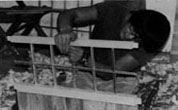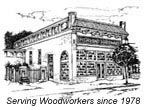|
||||||||
|
|
||||||||
|
|
|
|||
|
Seth Rolland On Design and
Creativity
Wood News: Describe your design process. Seth Rolland: My designs usually start with an idea which can be a motion I want the piece to have, or a stance with a particular balance. It can be the way certain forms will look when they intersect or are placed next to each other. These ideas are most often derived from forms I find in nature - the way a tree branch joins to the trunk, the way a bird stands, or the shape of a whale's tail. Other designs begin as an exploration of a particular technique which I will push to a limit to work wood into unusual forms. I enjoy seeing what shapes I can make with certain techniques (most often laminating and steam bending) and then figuring out how I might use these forms in a furniture design.
WN: After creating a new design, what is the process for moving the idea forward eventually resulting in a finished piece? SR: My designs usually start with small thumbnail sketches, then I turn them into quarter scale drawings. Often I will make a quarter scale model so I can look at it from various sides. I also use these models to check the stability of a table with an overhang. Then I draw the piece out full scale to refine the shapes and proportions, often moving a line here or there on the drawing for a week or two as it sits in the shop. I use the drawings to make any templates I might need for repetitive parts and to figure out all the joinery. At this point construction usually proceeds pretty smoothly.
WN: What is the fascination with curves in your work and how do you think they impact the reaction someone has when they view a piece? SR: I think straight lines, grids and geometry are great ways to organize space. They add order and calm to our universe. Photographs are a great example: the rectangular edge organizes and enhances the mostly organic forms inside. A free edge photo might be unsettling. I like straight lined and geometric furniture for its serene and unimposing presence. However, almost nothing alive has any straight lines. When I add curves to a table or chair leg they no longer just sit on the floor, they touch it lightly, or spring from it, or are anchored to it. For me, sitting in a curved chair is much more comforting than a shaker style chair: I am not trying to fit into a grid, but am embraced. The curves are more fun to touch and run fingers along. It has more the feel of sitting on a log in the woods than sitting on a brick wall in the city. In my experiences when showing my work people always need to run their fingers along the curved pieces first and talk about how warm wood is, but I think it is really the curves they are talking about.
WN: Is it possible to take an existing design that utilizes straight lines and reinvent it by altering the design and introducing curves? SR: Absolutely. In fact, most of my pieces I design within a rectangular grid, as there is usually a required height, width and depth to the piece. So I start within a rectangle and always leave quite a few straight lines. If every line is curved a piece will look too wiggly. The curves usually need some straight lines to work off, to help show them as curves. So starting with an existing geometric design is easy. You just need to picture it with legs curved this way or that, or with a curved top or apron and see how it changes the feel of the piece.
WN: Describe your shop and the tools / equipment that you feel are critical. SR: My shop is 800 square feet. Not overly large, but organized and not too filled with large tools. Empty workspace is the most important part of my shop, though it is hard to keep any space empty for long. I have a radial arm saw, a joiner, planer, table saw, bandsaw, router table, stationary belt/disc sander, a large air compressor, and 2 dust collectors which I use every day. I also have a lathe, oscillating spindle sander, and a vacuum bag which I only use for specific projects. For small electric tools my 4 ½" grinder is my favorite and I use it for carving out seats and shaping large curves and stack laminations.
WN: What recommendations would you make for someone that is in the process of putting together their first shop? SR: Your shop needs to be a fun place to work. Think about what tools are most fun to use and start with those. For me that would be a bandsaw, some chisels and gouges and rasps. I'd also want some dust collection because dirty shops aren't fun to work in. Then worry about those other tools you may or may not need to get the job done like table saws, joiners and planers.
WN: What resources, books etc., were instrumental in the development of your style of design? SR: I grew up with a lot of exposure to art, design and museums. I've always been attracted to both Scandinavian and Japanese designs in the way they combine organic and geometric elements so differently and successfully. So I do have a few books on those. I have always liked "Designing Furniture" by Seth Stem. Otherwise, looking through books like "1000 Chairs" and books on the works of Gaudi, Brancusi, David Nash, and Andy Goldsworthy are inspiring.
Seth
Rolland works from his studio in Port Townsend, Washington. His work
can be seen by visiting him at:
www.sethrolland.com
.
|
|||
|




